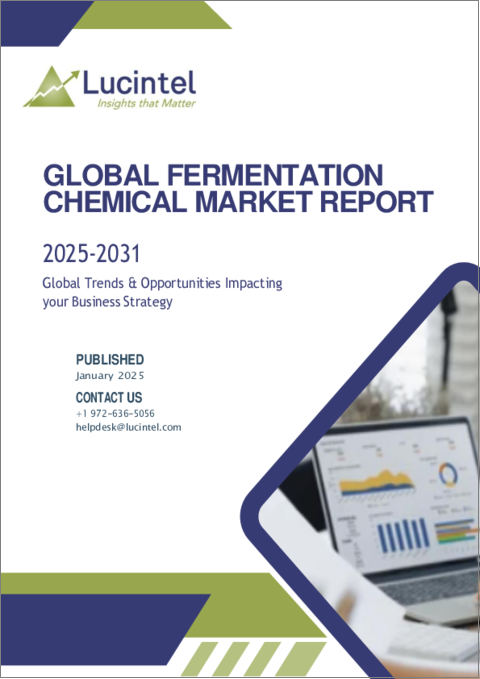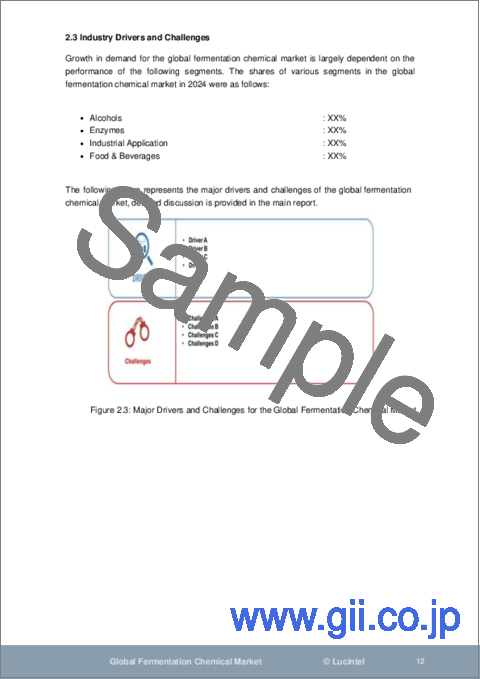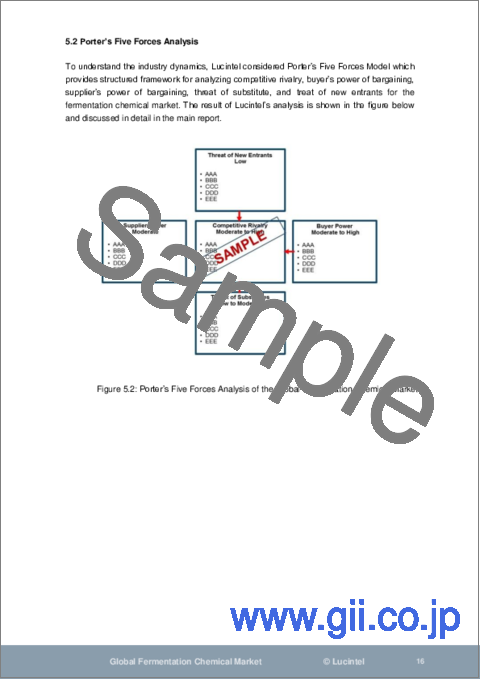|
|
市場調査レポート
商品コード
1560269
発酵化学品の市場レポート:2030年までの動向、予測、競合分析Fermentation Chemical Market Report: Trends, Forecast and Competitive Analysis to 2030 |
||||||
カスタマイズ可能
適宜更新あり
|
|||||||
| 発酵化学品の市場レポート:2030年までの動向、予測、競合分析 |
|
出版日: 2024年09月01日
発行: Lucintel
ページ情報: 英文 150 Pages
納期: 3営業日
|
- 全表示
- 概要
- 目次
発酵化学品の動向と予測
世界の発酵化学品市場は、2024年から2030年までのCAGRが5.8%で、2030年までに推定1,207億米ドルに達すると予想されています。この市場の主な促進要因は、バイオベース原料の需要拡大と、繊維・プラスチック製造部門からの各種有機酸の需要増です。世界の発酵化学品市場の将来は、工業用途、食品・飲料、栄養・製薬、プラスチック・繊維用途での機会で有望視されています。
Lucintelは、食品・飲料、製薬、化粧品など様々な産業からの需要の増加により、アルコールが予測期間中に最も高い成長を遂げると予測しています。
この市場の中では、工業用途が予測期間中に最も高い成長を遂げると予想されています。
北米は、医薬品、工業、食品・飲料など様々な最終用途産業からの発酵化学品に対する幅広い需要により、予測期間中最も高い成長が見込まれています。
よくある質問
Q1.市場規模は:
A1.世界の発酵化学品市場は、2030年までに推定1,207億米ドルに達すると予想されています。
Q2.市場の成長予測は:
A2.世界の発酵化学品市場は、2024年から2030年にかけてCAGR 5.8%で成長すると予想されます。
Q3.市場の成長に影響を与える主な促進要因は:
A3.この市場の主な促進要因は、バイオベース原料の需要拡大と、繊維・プラスチック製造部門からの各種有機酸の需要増です。
Q4.市場の主要セグメントは:
A4.発酵化学品市場の将来は、工業用途、食品・飲料、栄養・製薬、プラスチック・繊維の各用途における機会で有望視されています。
Q5.市場の主要企業は:
A5.主要な発酵化学品企業は以下の通りです:
- BASF SE
- Novozymes
- DuPont Danisco
- DSM
- Amano Enzymes
Q6.今後、最大となる市場セグメントは:
A6.Lucintelは、食品・飲料、医薬品、化粧品など様々な産業からの需要の増加により、アルコールが予測期間中に最も高い成長を遂げると予測しています。
Q7.市場において、今後5年間に最大になると予想される地域は:
A7.北米は、この地域の医薬品、工業、食品・飲料など様々な最終用途産業からの発酵化学品に対する広範な需要により、予測期間中に最も高い成長を示すと予想されます。
Q8.レポートのカスタマイズは可能か:
A8.はい、Lucintelは追加費用なしで10%のカスタマイズを提供します。
目次
第1章 エグゼクティブサマリー
第2章 世界の発酵化学品市場:市場力学
- イントロダクション、背景、分類
- サプライチェーン
- 業界の促進要因と課題
第3章 2018年から2030年までの市場動向と予測分析
- マクロ経済動向(2018~2023年)と予測(2024~2030年)
- 世界の発酵化学品市場の動向(2018~2023年)と予測(2024~2030年)
- 製品別世界発酵化学品市場
- アルコール
- 酵素
- 有機酸
- その他
- 用途別世界発酵化学品市場
- 工業用途
- 食品・飲料
- 栄養・医薬品
- プラスチック・繊維
- その他
第4章 2018年から2030年までの地域別市場動向と予測分析
- 地域別の世界の発酵化学品市場
- 北米の発酵化学品市場
- 欧州の発酵化学品市場
- アジア太平洋の発酵化学品市場
- その他地域の発酵化学品市場
第5章 競合分析
- 製品ポートフォリオ分析
- 運用統合
- ポーターのファイブフォース分析
第6章 成長機会と戦略分析
- 成長機会分析
- 製品別の世界の発酵化学品市場の成長機会
- 用途別の世界の発酵化学品市場の成長機会
- 地域別の世界の発酵化学品市場の成長機会
- 世界の発酵化学品市場の新たな動向
- 戦略分析
- 新製品開発
- 世界の発酵化学品市場の生産能力拡大
- 世界の発酵化学品市場における合併、買収、合弁事業
- 認証とライセンシング
第7章 主要企業の企業プロファイル
- BASF SE
- Novozymes
- DuPont Danisco
- DSM
- Amano Enzymes
Fermentation Chemical Trends and Forecast
The future of the global fermentation chemical market looks promising with opportunities in the industrial application, food & beverage, nutritional & pharmaceutical, and plastics & fibers applications. The global fermentation chemical market is expected to reach an estimated $120.7 billion by 2030 with a CAGR of 5.8% from 2024 to 2030. The major drivers for this market are growing demand for demand for bio-based feedstock and rising demand for various organic acids from fiber and plastic manufacturing sector.
Lucintel forecasts that alcohol is expected to witness the highest growth over the forecast period due to its increasing demand from variety of industries, such as food and beverages, pharmaceuticals, and cosmetics.
Within this market, industrial is expected to witness the highest growth over the forecast period.
North America is expected to witness the highest growth over the forecast period due to extensive demand for fermentation chemicals from various end use industries, such as pharmaceuticals, industrial, and food & beverages in the region.
Emerging Trends in the Fermentation Chemical Market
The fermentation chemicals sector is experiencing transformative trends that are shaping its future. These trends are driven by technological advancements, sustainability goals, and the evolving needs of various industries.
- Sustainability and Green Chemistry: Emphasis on eco-friendly processes and reducing environmental impact is growing. Companies are adopting green chemistry principles to develop biobased chemicals and minimize waste, aligning with global sustainability goals.
- Advanced Enzyme Technology: Innovations in enzyme technology are enhancing fermentation efficiency and specificity. Advanced enzymes enable more effective breakdown of substrates and higher yields, improving overall process economics and product quality.
- Microbial Strain Engineering: The development of genetically modified microorganisms is revolutionizing fermentation processes. Engineered strains offer improved performance, higher product yields, and the ability to produce a wider range of chemicals.
- Integration with Digital Technologies: The use of digital technologies, such as process automation and data analytics, is increasing in fermentation. These tools optimize fermentation conditions, enhance process control, and enable real-time monitoring.
- Focus on Specialty Chemicals: There is a growing trend towards producing high-value specialty chemicals through fermentation. This includes pharmaceuticals, biofuels, and advanced materials, catering to niche markets with high demand for precision and quality.
These trends are reshaping the fermentation chemicals sector by promoting sustainability, enhancing process efficiency, and expanding the range of products. Companies are leveraging these trends to drive innovation and meet the growing demand for eco-friendly and high-value chemicals.
Recent Developments in the Fermentation Chemical Market
Recent developments in fermentation chemicals highlight significant technological advancements and strategic shifts in the industry. These developments are influencing production techniques, product offerings, and market dynamics.
- Enhanced Biobased Production Methods: Innovations in biobased production methods are improving the efficiency and scalability of fermentation processes. New techniques are enabling the production of a wider range of chemicals from renewable resources.
- Advancements in Process Optimization: Improved process optimization technologies are increasing yields and reducing costs. This includes advancements in fermentation vessel design, nutrient management, and process control systems.
- Development of High-Yield Microbial Strains: Genetic engineering has led to the creation of high-yield microbial strains. These strains enhance production efficiency and enable the synthesis of complex chemicals with higher purity and lower costs.
- Integration of Automation and AI: Automation and artificial intelligence are being integrated into fermentation processes. These technologies enhance process monitoring, optimize conditions, and improve overall process management.
- Expansion of Applications in Pharmaceuticals: Fermentation chemicals are increasingly used in the pharmaceutical industry for producing antibiotics, vaccines, and other therapeutic compounds. This expansion is driven by advancements in microbial fermentation and strain development.
These developments are advancing the fermentation chemicals sector by improving production methods, increasing efficiency, and expanding applications. The integration of new technologies and processes is driving innovation and shaping the future of the industry.
Strategic Growth Opportunities for Fermentation Chemical Market
The fermentation chemicals sector offers numerous growth opportunities across various applications. Identifying and leveraging these opportunities can drive expansion and innovation in the industry.
- Biofuels Production: The demand for renewable energy sources is driving growth in biofuels production through fermentation. This opportunity includes developing efficient processes for producing bioethanol, biodiesel, and other biofuels.
- Pharmaceutical Manufacturing: Fermentation is crucial for producing antibiotics, vaccines, and other pharmaceuticals. Expanding capabilities in this area can enhance drug production and meet increasing global healthcare needs.
- Agricultural Chemicals: The use of fermentation chemicals in agriculture, such as bio-pesticides and bio-fertilizers, offers growth opportunities. These products support sustainable farming practices and improve crop yields.
- Specialty Chemicals: There is a growing market for specialty chemicals produced through fermentation, including high-value polymers and advanced materials. This segment offers opportunities for innovation and differentiation.
- Consumer Goods: Fermentation chemicals are increasingly used in consumer goods, such as flavorings, fragrances, and health supplements. This market segment presents opportunities for developing new products and expanding consumer applications.
These growth opportunities highlight the potential for expanding fermentation chemicals across diverse applications. By focusing on biofuels, pharmaceuticals, agricultural chemicals, specialty chemicals, and consumer goods, companies can drive innovation and capture new market segments.
Fermentation Chemical Market Driver and Challenges
The fermentation chemicals industry is shaped by various drivers and challenges, including technological advancements, economic factors, and regulatory issues. Understanding these factors is crucial for navigating the market and achieving growth.
The factors responsible for driving the fermentation chemical market include:
1. Technological Advancements: Innovations in fermentation technology, such as advanced enzyme systems and microbial engineering, drive efficiency and product development. These advancements enhance yields and reduce production costs.
2. Rising Demand for Sustainable Products: Growing consumer and regulatory demand for sustainable and eco-friendly products drives innovation in biobased chemicals. Companies are adopting green chemistry principles to meet these demands.
3. Increasing Applications in Pharmaceuticals: The expansion of fermentation chemicals in pharmaceuticals boosts market growth. Fermentation processes are essential for producing a wide range of therapeutic compounds.
4. Supportive Government Policies: Government policies and incentives supporting biotechnological advancements and sustainable practices encourage investment and innovation in fermentation chemicals.
5. Global Demand for Biofuels: The increasing global demand for renewable energy sources, such as biofuels, drives growth in fermentation processes. Biofuels offer an alternative to fossil fuels and contribute to environmental sustainability.
Challenges in the fermentation chemical market are:
1. High Production Costs: The cost of developing and scaling up fermentation processes can be high. This includes expenses related to technology, raw materials, and infrastructure, which can impact profitability.
2. Regulatory Compliance: Navigating complex regulatory environments for product approvals and safety standards can be challenging. Compliance with varying regulations across regions adds complexity to operations.
3. Market Competition: Intense competition in the fermentation chemicals sector can impact market share and profitability. Companies must innovate continuously to stay ahead of competitors.
4. Supply Chain Disruptions: Disruptions in the supply chain, including raw material shortages and logistical issues, can affect production and delivery schedules. Companies need robust supply chain management strategies.
5. Technological Integration Issues: Integrating new technologies with existing systems can be complex and costly. Ensuring compatibility and effective implementation is crucial for maintaining operational efficiency.
The drivers and challenges in fermentation chemicals reflect the dynamic nature of the industry. Technological advancements and sustainability trends are key growth drivers, while high costs and regulatory issues present challenges. Addressing these factors effectively is essential for navigating the market and achieving success.
List of Fermentation Chemical Companies
Companies in the market compete on the basis of product quality offered. Major players in this market focus on expanding their manufacturing facilities, R&D investments, infrastructural development, and leverage integration opportunities across the value chain. With these strategies fermentation chemical companies cater increasing demand, ensure competitive effectiveness, develop innovative products & technologies, reduce production costs, and expand their customer base. Some of the fermentation chemical companies profiled in this report include-
- BASF SE
- Novozymes
- DuPont Danisco
- DSM
- Amano Enzymes
Fermentation Chemical by Segment
The study includes a forecast for the global fermentation chemical by product, application, and region.
Fermentation Chemical Market by Product [Analysis by Value from 2018 to 2030]:
- Alcohols
- Enzymes
- Organic Acids
- Others
Fermentation Chemical Market by Application [Analysis by Value from 2018 to 2030]:
- Industrial Application
- Food & Beverages
- Nutritional and Pharmaceutical
- Plastics and Fibers
- Others
Fermentation Chemical Market by Region [Analysis by Value from 2018 to 2030]:
- North America
- Europe
- Asia Pacific
- The Rest of the World
Country Wise Outlook for the Fermentation Chemical Market
Major players in the market are expanding their operations and forming strategic partnerships to strengthen their positions. Below image highlights recent developments by major fermentation chemicals producers in key regions: the USA, China, India, Japan, and Germany
- United States: In the U.S., there has been a surge in the development of biobased chemicals and sustainable fermentation processes. Companies are focusing on reducing carbon footprints and increasing efficiency through advancements in enzyme technology and genetic engineering.
- China: China is rapidly expanding its fermentation chemical industry, with a strong emphasis on scaling up production capacities and improving quality control. Investments are directed towards enhancing the use of renewable resources and developing high-yield fermentation processes for various chemicals.
- Germany: Germany is at the forefront of integrating fermentation chemicals into green technologies. Recent developments include innovations in microbial fermentation for the production of bio-based polymers and advanced biofuels, supporting the country's commitment to sustainable industrial practices.
- India: India is focusing on enhancing the efficiency of fermentation processes in pharmaceutical and agricultural sectors. The country is investing in research to improve strain development and process optimization, aiming to boost the production of essential chemicals and enzymes.
- Japan: Japan is advancing fermentation chemical technologies with a focus on precision fermentation and high-value products. The country is developing novel fermentation methods for producing specialty chemicals and pharmaceuticals, driven by strong research and development efforts.
Features of the Global Fermentation Chemical Market
Market Size Estimates: Fermentation chemical market size estimation in terms of value ($B).
Trend and Forecast Analysis: Market trends (2018 to 2023) and forecast (2024 to 2030) by various segments and regions.
Segmentation Analysis: Fermentation chemical market size by product, application, and region in terms of value ($B).
Regional Analysis: Fermentation chemical market breakdown by North America, Europe, Asia Pacific, and Rest of the World.
Growth Opportunities: Analysis of growth opportunities in different products, applications, and regions for the fermentation chemical market.
Strategic Analysis: This includes M&A, new product development, and competitive landscape of the fermentation chemical market.
Analysis of competitive intensity of the industry based on Porter's Five Forces model.
If you are looking to expand your business in this or adjacent markets, then contact us. We have done hundreds of strategic consulting projects in market entry, opportunity screening, due diligence, supply chain analysis, M & A, and more.
FAQ
Q1. What is the fermentation chemical market size?
Answer: The global fermentation chemical market is expected to reach an estimated $120.7 billion by 2030.
Q2. What is the growth forecast for fermentation chemical market?
Answer: The global fermentation chemical market is expected to grow with a CAGR of 5.8% from 2024 to 2030.
Q3. What are the major drivers influencing the growth of the fermentation chemical market?
Answer: The major drivers for this market are growing demand for demand for bio-based feedstock and rising demand for various organic acids from fiber and plastic manufacturing sector.
Q4. What are the major segments for fermentation chemical market?
Answer: The future of the fermentation chemical market looks promising with opportunities in the industrial application, food & beverage, nutritional & pharmaceutical, and plastics & fibers applications.
Q5. Who are the key fermentation chemical market companies?
Answer: Some of the key fermentation chemical companies are as follows:
- BASF SE
- Novozymes
- DuPont Danisco
- DSM
- Amano Enzymes
Q6. Which fermentation chemical market segment will be the largest in future?
Answer: Lucintel forecasts that alcohol is expected to witness the highest growth over the forecast period due to its increasing demand from variety of industries, such as food and beverages, pharmaceuticals, and cosmetics.
Q7. In fermentation chemical market, which region is expected to be the largest in next 5 years?
Answer: North America is expected to witness the highest growth over the forecast period due to extensive demand for fermentation chemicals from various end use industries, such as pharmaceuticals, industrial, and food & beverages in the region.
Q.8 Do we receive customization in this report?
Answer: Yes, Lucintel provides 10% customization without any additional cost.
This report answers following 11 key questions:
- Q.1. What are some of the most promising, high-growth opportunities for the fermentation chemical market by product (alcohols, enzymes, organic acids, and others), application (industrial application, food & beverages, nutritional and pharmaceutical, plastics and fibers, and others), and region (North America, Europe, Asia Pacific, and the Rest of the World)?
- Q.2. Which segments will grow at a faster pace and why?
- Q.3. Which region will grow at a faster pace and why?
- Q.4. What are the key factors affecting market dynamics? What are the key challenges and business risks in this market?
- Q.5. What are the business risks and competitive threats in this market?
- Q.6. What are the emerging trends in this market and the reasons behind them?
- Q.7. What are some of the changing demands of customers in the market?
- Q.8. What are the new developments in the market? Which companies are leading these developments?
- Q.9. Who are the major players in this market? What strategic initiatives are key players pursuing for business growth?
- Q.10. What are some of the competing products in this market and how big of a threat do they pose for loss of market share by material or product substitution?
- Q.11. What M&A activity has occurred in the last 5 years and what has its impact been on the industry?
- Market Report
Table of Contents
1. Executive Summary
2. Global Fermentation Chemical Market : Market Dynamics
- 2.1: Introduction, Background, and Classifications
- 2.2: Supply Chain
- 2.3: Industry Drivers and Challenges
3. Market Trends and Forecast Analysis from 2018 to 2030
- 3.1. Macroeconomic Trends (2018-2023) and Forecast (2024-2030)
- 3.2. Global Fermentation Chemical Market Trends (2018-2023) and Forecast (2024-2030)
- 3.3: Global Fermentation Chemical Market by Product
- 3.3.1: Alcohols
- 3.3.2: Enzymes
- 3.3.3: Organic Acids
- 3.3.4: Others
- 3.4: Global Fermentation Chemical Market by Application
- 3.4.1: Industrial Application
- 3.4.2: Food & Beverages
- 3.4.3: Nutritional and Pharmaceutical
- 3.4.4: Plastics and Fibers
- 3.4.5: Others
4. Market Trends and Forecast Analysis by Region from 2018 to 2030
- 4.1: Global Fermentation Chemical Market by Region
- 4.2: North American Fermentation Chemical Market
- 4.2.1: North American Fermentation Chemical Market by Product: Alcohols, Enzymes, Organic Acids, and Others
- 4.2.2: North American Fermentation Chemical Market by Application: Industrial Application, Food & Beverages, Nutritional and Pharmaceutical, Plastics and Fibers, and Others
- 4.3: European Fermentation Chemical Market
- 4.3.1: European Fermentation Chemical Market by Product: Alcohols, Enzymes, Organic Acids, and Others
- 4.3.2: European Fermentation Chemical Market by Application: Industrial Application, Food & Beverages, Nutritional and Pharmaceutical, Plastics and Fibers, and Others
- 4.4: APAC Fermentation Chemical Market
- 4.4.1: APAC Fermentation Chemical Market by Product: Alcohols, Enzymes, Organic Acids, and Others
- 4.4.2: APAC Fermentation Chemical Market by Application: Industrial Application, Food & Beverages, Nutritional and Pharmaceutical, Plastics and Fibers, and Others
- 4.5: ROW Fermentation Chemical Market
- 4.5.1: ROW Fermentation Chemical Market by Product: Alcohols, Enzymes, Organic Acids, and Others
- 4.5.2: ROW Fermentation Chemical Market by Application: Industrial Application, Food & Beverages, Nutritional and Pharmaceutical, Plastics and Fibers, and Others
5. Competitor Analysis
- 5.1: Product Portfolio Analysis
- 5.2: Operational Integration
- 5.3: Porter's Five Forces Analysis
6. Growth Opportunities and Strategic Analysis
- 6.1: Growth Opportunity Analysis
- 6.1.1: Growth Opportunities for the Global Fermentation Chemical Market by Product
- 6.1.2: Growth Opportunities for the Global Fermentation Chemical Market by Application
- 6.1.3: Growth Opportunities for the Global Fermentation Chemical Market by Region
- 6.2: Emerging Trends in the Global Fermentation Chemical Market
- 6.3: Strategic Analysis
- 6.3.1: New Product Development
- 6.3.2: Capacity Expansion of the Global Fermentation Chemical Market
- 6.3.3: Mergers, Acquisitions, and Joint Ventures in the Global Fermentation Chemical Market
- 6.3.4: Certification and Licensing
7. Company Profiles of Leading Players
- 7.1: BASF SE
- 7.2: Novozymes
- 7.3: DuPont Danisco
- 7.4: DSM
- 7.5: Amano Enzymes





